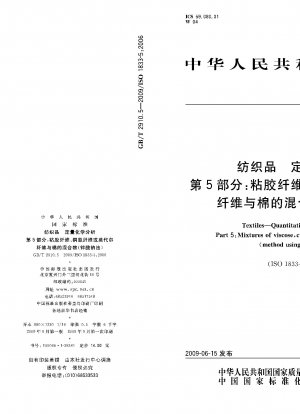GB/T 2910.5-2009
Textiles.Quantitative chemical analysis.Part 5:Mixtures of viscose,cupro or modal and cotton fibres(method using sodium zincate) (English Version)
- Standard No.
- GB/T 2910.5-2009
- Language
- Chinese, Available in English version
- Release Date
- 2009
- Published By
- General Administration of Quality Supervision, Inspection and Quarantine of the People‘s Republic of China
- Latest
- GB/T 2910.5-2009
- Scope
- This part of GB/T 2910 specifies the use of sodium zincate method to determine the two components of viscose fiber after removal of non-fibrous substances, or most existing cupro ammonia fiber or modal fiber and raw cotton, boiled cotton or bleached cotton fiber Method of mixture content. If cupro ammonia fiber or modal fiber exists in the sample, it should be pre-tested whether it is soluble in the reagent. This section does not apply to cotton fibers in mixtures that have been subjected to severe chemical degradation, or to viscose, cupro, or modal fibers in which durable finishes or reactive dyes are present that cannot be completely removed, rendering them incompletely soluble. .
GB/T 2910.5-2009 Referenced Document
- GB/T 2910.1-2009 Textiles.Quantitative chemical analysis.Part 1:General principles of testing
GB/T 2910.5-2009 history
- 2009 GB/T 2910.5-2009 Textiles.Quantitative chemical analysis.Part 5:Mixtures of viscose,cupro or modal and cotton fibres(method using sodium zincate)

GB/T 2910.5-2009 -All Parts
GB/T 2910.1-2009 Textiles.Quantitative chemical analysis.Part 1:General principles of testing
GB/T 2910.10-2009 Textiles.Quantitative chemical analysis.Part 10:Mixtures of triacetate or polylactide and certain other fibres(method using dichloromethane)
GB/T 2910.101-2009 Textiles.Quantitative chemical analysis.Part 101:Mixtures of soybean protein composite fibre and certain other fibers
GB/T 2910.11-2009 Textiles.Quantitative chemical analysis.Part 11:Mixtures of cellulose and polyester fibres(method using sulfuric acid)
GB/T 2910.12-2023 Quantitative chemical analysis of textiles - Part 12: Mixtures of polyacrylonitrile fibers, certain modacrylic fibers, certain chlorine-containing fibers, or certain polyurethane elastic fibers with certain other fibers (dimethylformamide method)
GB/T 2910.13-2009 Textiles.Quantitative chemical analysis.Part 13:Mixtures of certain chlorofibers and certain other fibers(method using carbon disulfide/acetone)
GB/T 2910.14-2009 Textiles.Quantitative chemical analysis.Part 14:Mixtures of acetate and certain chlorofibres(method using acetic acid)
GB/T 2910.15-2009 Textiles.Quantitative chemical analysis.Part 15:Mixtures of jute and certain animal fibres(method by determining nitrogen content )
GB/T 2910.16-2024 Textiles - Quantitative chemical analysis - Part 16: Mixtures of polypropylene fibers with certain other fibers (xylene method)
GB/T 2910.17-2009 Textiles.Quantitative chemical analysis.Part 17:Mixtures of chlorofibers(homopolymers of vinyl chloride)and certain other fibers(method using sulfuric acid )
GB/T 2910.18-2009 Textiles.Quantitative chemical analysis.Part 18:Mixtures of silk and wool or hair(method using sulfuric acid)
GB/T 2910.19-2009 Textiles.Quantitative chemical analysis.Part 19:Mixtures of cellulose fibres and asbestos(method by heating )
GB/T 2910.2-2009 Textiles.Quantitative chemical analysis.Part 2:Ternary fibre mixture
GB/T 2910.20-2009 Textiles.Quantitative chemical analysis.Part 20:Mixtures of elastane and some other fibers(method of using dimethylacetamide)
GB/T 2910.21-2009 Textiles.Quantitative chemical analysis.Part 21:Mixtures of chlorofibers,certain modacrylics,certain elastanes,acetates,triacetates and certain other fibers(method using cyclohexanone)
GB/T 2910.22-2009 Textiles.Quantitative chemical analysis.Part 22:Mixtures of viscose or certain types of cupro or modal or lyocell and flax of ramie fibres(method using formic acid and zinc chloride)
GB/T 2910.23-2009 Textiles.Quantitative chemical analysis.Part 23:Mixtures of polyethylene and polypropylene(method using cyclohexanone)
GB/T 2910.24-2009 Textiles.Quantitative chemical analysis.Part 24:Mixtures of polyester and some other fibers(method using phenol and tetrachloroethane)
GB/T 2910.25-2017 Textiles—Quantitative chemical analysis—Part 25:Mixtures of polyester and certain other fibres(method using trichloroacetic acid and chloroform)
GB/T 2910.26-2017 Textiles—Qualitative chemical analysis—Part 26:Mixtures of melamine and cotton or aramide fibers(method using hot formic acid)
GB/T 2910.3-2009 Textiles.Quantitative chemical analysis.Part 3:Mixtures of acetate and certain other fibres(method using acetone)
GB/T 2910.4-2022 Textiles—Quantitative chemical analysis—Part 4:Mixtures of certain protein fibres with certain other fibres (method using hypochlorite)
GB/T 2910.5-2009 Textiles.Quantitative chemical analysis.Part 5:Mixtures of viscose,cupro or modal and cotton fibres(method using sodium zincate)
GB/T 2910.6-2009 Textiles.Quantitative chemical analysis.Part 6:Mixtures of viscose or certain types of cupro or modal or lyocell and cotton fibres(method using formic acid and zinc chloride)
GB/T 2910.7-2009 Textiles.Quantitative chemical analysis.Part 7:Mixtures of polyamide and certain other fibres(method using formic acid)
GB/T 2910.8-2009 Textiles.Quantitative chemical analysis.Part 8:Mixtures of acetate and triacetate fibres(method using acetone)
GB/T 2910.9-2024 Textiles - Quantitative chemical analysis - Part 9: Mixtures of acetate fibers with certain other fibers (benzyl alcohol method)